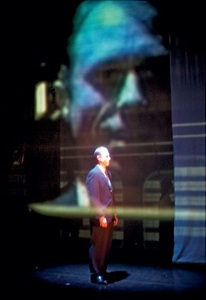On 17
December, landscape architect Jo Yeates, from Clifton, Bristol, went
missing. Her body was discovered some miles away, in North Somerset, on
Christmas Day. She had been strangled. It’s a terribly sad story.
The next day, Yeates’s landlord, Chris
Jefferies, a retired school teacher, was arrested. His photograph was
all over the news and many newspapers and tabloids have run stories
about his eccentricity.
It’s absolutely fucking disgusting.
First and foremost because he should be assumed to be innocent before
proven guilty. Yet most of the news reports seem to be treating him as
guilty. As a result, it strikes me as most unlikely that he could
possibly have a fair trial. If he were Yeates’s murderer, the risk is
that he could get off because justice cannot be done. If he isn’t the
murderer, they are destroying his reputation and, I hope, opening
themselves up to many millions of pounds in damages. Second, though,
it’s a horrifying glimpse of what middle England thinks makes someone a
vile, creepy eccentric.
Look at this revolting article
from The Sun (it's an archived copy of the page, no traffic to Murdoch). Chris Jefferies was ‘obsessed with
death’. Evidence? He showed schoolchildren Alain Resnais’s 1955
masterpiece Night and Fog, a documentary about the Nazi concentration camps. What other evidence? Well, he was also ‘particularly fascinated’ with The Moonstone.
Yes, the sick-minded death-loving weirdo had the temerity to enjoy a
classic nineteenth-century novel by Wilkie Collins. I am writing to
Penguin Classics, demanding they withdraw this literary nasty from their
list. Other reports have claimed that the evil twisted pervert enjoyed
the work of Christina Rossetti. I have checked on Wikipedia and
apparently she is herself also dead: very suspicious. Where was morbid
oddball Chris Jefferies in December 1894, I wonder?
Apparently this adds up to an ‘academic
obsession’ with death, which in the headline becomes ‘obsessed by
death’. What kind of person doesn’t think about death? Doesn’t think it
is part of living an reflective life to consider death from all sides,
and draw on documentary, literature, poetry to help us come to some
emotional accommodation with this mystery? Perhaps The Sun would care to list a few great works of literature that sunnily refuse to acknowledge any of the darker sides of life.
This isn’t the only evidence of his
twisted lifestyle, of course. Damningly he had a blue-rinse and
cultivated the kind of aloof teacherly eccentricity that all teachers do. He was an ‘oddball’ and was ‘flamboyant’ which as we all know are psychopathic conditions extensively documented in the Diagnostic and Statistical Manual of Mental Disorders.
Elsewhere in the article we hear that he invited a class to his flat
for a book reading and, suspiciously, nothing ontoward happens. How
devious, how sinister. Exactly what a killer would do.
Who knows whether they have accurately
quoted his neighbour, Peter Stanley, who appears to have made his mind
up already. If Jefferies is cleared, that’s going to make for a cheery
meeting of the Neighbourhood Watch.
And note, right at the bottom of the
article, ‘Jefferies has been arrested on suspicion of strangling Jo
following "concerns" about his statement. But detectives are yet to find
any evidence linking him to the crime.’ YET TO FIND ANY EVIDENCE. Oh
but the tabloids have found plenty. He likes nineteenth-century poetry.
String the fucker up.
Yesterday, Jo Yeates’s parents and her
boyfriend, Greg Reardon, released moving statements. The tabloids
focused on the moving comments of the parents and most of them
downplayed Reardon’s ballsy and righteous remarks. Here they are:
Jo's life was cut short tragically but the finger-pointing and character assassination by social and news media of as yet innocent men has been shameful.
It has made me lose a lot of faith in the morality of the British Press and those that spend their time fixed to the internet in this modern age.
I hope in the future they will show a more sensitive and impartial view to those involved in such heart-breaking events and especially in the lead-up to potentially high-profile court cases.
God forbid, but if I had to make such a
statement, I hope I would have the moral and mental strength to make
such a level-headed assessment of the coverage. I notice the neither The Sun nor The Daily Mail mention this part of his statement. The Mirror lies and says his comments were aimed only at ‘internet ghouls’ and makes no mention of the ‘morality of the British Press’.
The tabloids are just trying to sell
papers, we are told. Yes, it’s considered a defence to say ‘I know we’re
damaging the chances of a fair trial and destroying a man’s reputation,
but you must remember we aim to make money out of doing so’. In fact,
of course, they are revealing the very worst kind of sloppy thinking,
mean-minded suspicion and cynicism, and a deep hatred of any kind of
difference.
I have no idea, of course, whether Chris Jefferies strangled Jo Yeates, but I do know that right now he should be treated as innocent - even if he did it - and the behaviour of these newspapers is a disgrace. The Contempt of Court Act 1981 allows for unlimited damages and does not require any intent for an offence to be committed. I hope it is invoked.





![photo[1].jpg](https://images.squarespace-cdn.com/content/v1/513c543ce4b0abff73bc0a82/1362919072201-PZO854G4SEB794DVOEI8/photo%5B1%5D.jpg)
